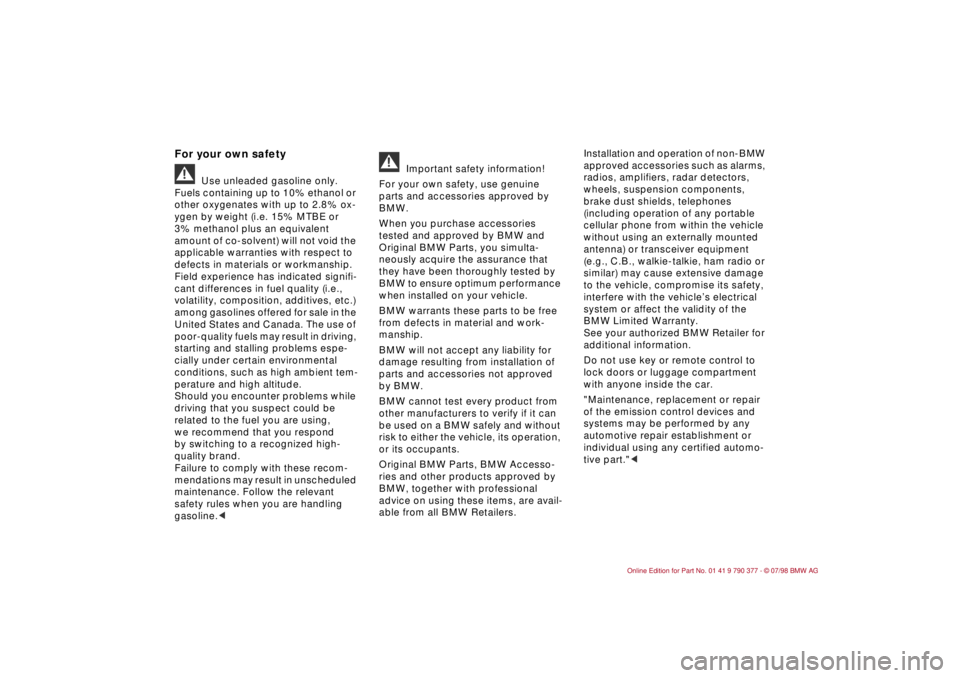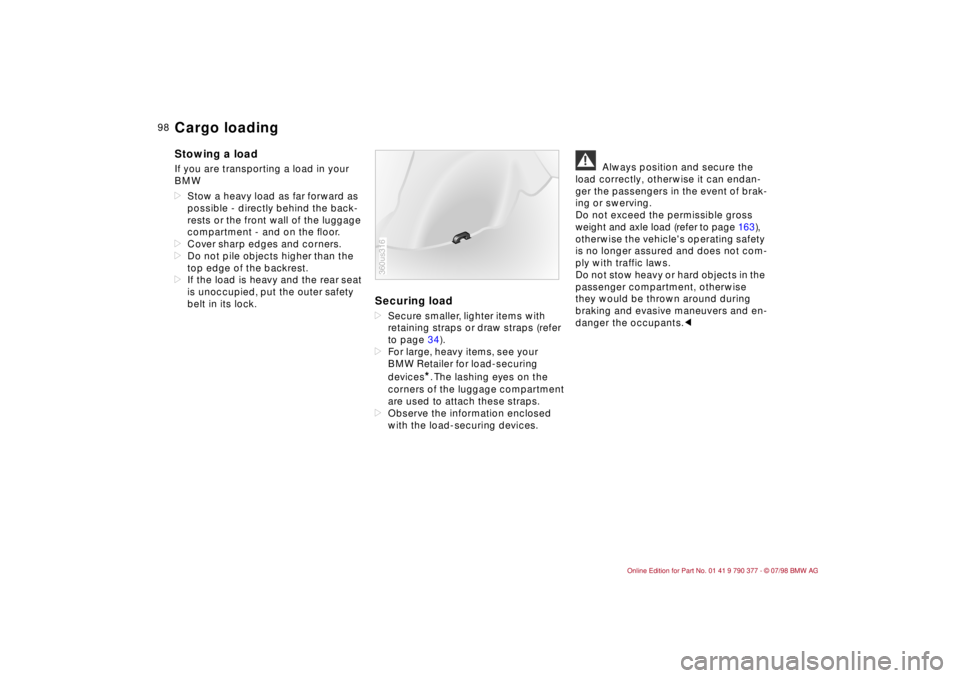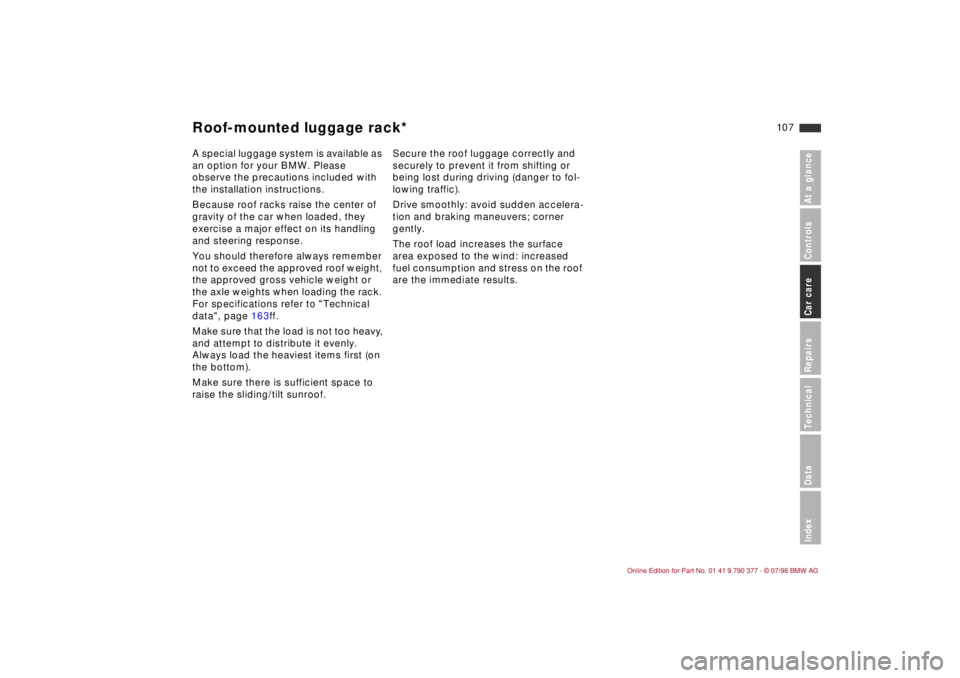1998 BMW CONVERTIBLE weight
[x] Cancel search: weightPage 7 of 179

For your own safety
a
Use unleaded gasoline only.
Fuels containing up to 10% ethanol or
other oxygenates with up to 2.8% ox-
ygen by weight (i.e. 15% MTBE or
3% methanol plus an equivalent
amount of co-solvent) will not void the
applicable warranties with respect to
defects in materials or workmanship.
Field experience has indicated signifi-
cant differences in fuel quality (i.e.,
volatility, composition, additives, etc.)
among gasolines offered for sale in the
United States and Canada. The use of
poor-quality fuels may result in driving,
starting and stalling problems espe-
cially under certain environmental
conditions, such as high ambient tem-
perature and high altitude.
Should you encounter problems while
driving that you suspect could be
related to the fuel you are using,
we recommend that you respond
by switching to a recognized high-
quality brand.
Failure to comply with these recom-
mendations may result in unscheduled
maintenance. Follow the relevant
safety rules when you are handling
gasoline.
c
a
Important safety information!
For your own safety, use genuine
parts and accessories approved by
BMW.
When you purchase accessories
tested and approved by BMW and
Original BMW Parts, you simulta-
neously acquire the assurance that
they have been thoroughly tested by
BMW to ensure optimum performance
when installed on your vehicle.
BMW warrants these parts to be free
from defects in material and work-
manship.
BMW will not accept any liability for
damage resulting from installation of
parts and accessories not approved
by BMW.
BMW cannot test every product from
other manufacturers to verify if it can
be used on a BMW safely and without
risk to either the vehicle, its operation,
or its occupants.
Original BMW Parts, BMW Accesso-
ries and other products approved by
BMW, together with professional
advice on using these items, are avail-
able from all BMW Retailers.Installation and operation of non-BMW
approved accessories such as alarms,
radios, amplifiers, radar detectors,
wheels, suspension components,
brake dust shields, telephones
(including operation of any portable
cellular phone from within the vehicle
without using an externally mounted
antenna) or transceiver equipment
(e.g., C.B., walkie-talkie, ham radio or
similar) may cause extensive damage
to the vehicle, compromise its safety,
interfere with the vehicleÕs electrical
system or affect the validity of the
BMW Limited Warranty.
See your authorized BMW Retailer for
additional information.
Do not use key or remote control to
lock doors or luggage compartment
with anyone inside the car.
"Maintenance, replacement or repair
of the emission control devices and
systems may be performed by any
automotive repair establishment or
individual using any certified automo-
tive part."
c
Page 13 of 179

Contents
Owner service procedure
Advanced technology
Technical data
Replacement procedures:
Onboard tool kit140
Windshield wiper blades140
Lamps and bulbs141
Master key with
battery lamp145
Changing tires146
Battery149
Fuses151
In case of electrical
malfunction:
Fuel filler door 152
Sliding/tilt sunroof 152
Assistance, giving and receiving:
Jump-starting153
Towing the vehicle154
Towing154Airbags156
Automatic Stability Control
plus Traction (ASC+T)156
Radio reception157
Safety belt tensioner157Engine specifications 160
Dimensions 161
Weights 163
Capacities 166
Electrical system 167
Drive belts 167
Page 99 of 179

98
Stowing a loadIf you are transporting a load in your
BMW
dStow a heavy load as far forward as
possible - directly behind the back-
rests or the front wall of the luggage
compartment - and on the ßoor.
dCover sharp edges and corners.
dDo not pile objects higher than the
top edge of the backrest.
dIf the load is heavy and the rear seat
is unoccupied, put the outer safety
belt in its lock.
Securing loaddSecure smaller, lighter items with
retaining straps or draw straps (refer
to page 34).
dFor large, heavy items, see your
BMW Retailer for load-securing
devices
*. The lashing eyes on the
corners of the luggage compartment
are used to attach these straps.
dObserve the information enclosed
with the load-securing devices.
a
Always position and secure the
load correctly, otherwise it can endan-
ger the passengers in the event of brak-
ing or swerving.
Do not exceed the permissible gross
weight and axle load (refer to page 16 3),
otherwise the vehicle's operating safety
is no longer assured and does not com-
ply with traffic laws.
Do not stow heavy or hard objects in the
passenger compartment, otherwise
they would be thrown around during
braking and evasive maneuvers and en-
danger the occupants.c
360us316
Cargo loading
Page 108 of 179

10 7
At a glanceControlsCar careRepairsTechnicalDataIndex
A special luggage system is available as
an option for your BMW. Please
observe the precautions included with
the installation instructions.
Because roof racks raise the center of
gravity of the car when loaded, they
exercise a major effect on its handling
and steering response.
You should therefore always remember
not to exceed the approved roof weight,
the approved gross vehicle weight or
the axle weights when loading the rack.
For specifications refer to "Technical
data", page 163ff.
Make sure that the load is not too heavy,
and attempt to distribute it evenly.
Always load the heaviest items first (on
the bottom).
Make sure there is sufficient space to
raise the sliding/tilt sunroof.Secure the roof luggage correctly and
securely to prevent it from shifting or
being lost during driving (danger to fol-
lowing traffic).
Drive smoothly: avoid sudden accelera-
tion and braking maneuvers; corner
gently.
The roof load increases the surface
area exposed to the wind: increased
fuel consumption and stress on the roof
are the immediate results.Roof-mounted luggage rack*
Page 147 of 179

14 6
a
Change tires only on a flat, hard
surface affording good traction. Avoid
jacking the car on a soft or slippery sup-
port surface (snow, ice, loose gravel,
etc.), as it could slide sideways.
Take extra care to ensure that the base
of the jack is positioned on a solid sup-
port surface.
Never use wooden blocks or similar
objects to support the base of the jack,
as the weight of the car could exceed
their support capacity.
Never lie beneath the vehicle or start
the engine while the car is supported by
the jack - risk of fatal injury.
Additional precautions to observe when
changing flat tires:
When pulling over on the roadside to
change a tire, always try to park the car
as far as possible from passing traffic.
Switch on the hazard flashers.
All passengers should be outside the
car and well away from your immediate
working area (e.g., behind the guard-
rail).Turn the steering wheel to the straight-
ahead position, remove the key and
engage the steering lock. Shift into 1st
or reverse (selector lever in Park with
automatic) and engage the parking
brake.
If a warning triangle or portable hazard
warning lamp is available, set it up on
the roadside at an appropriate distance
from the rear of the vehicle. Observe all
safety guidelines and regulations.c
b
To avoid rattling noises, note the
positions of the tools and return them to
their original positions.c
To change the tire you will need
Car jackIn the luggage compartment below the
floor mat at the right next to the spare
tire.
After using, screw the jack all the way
back down and insert it in its holder.Spare wheel and hexagon
adapter
*
Both are stored in the luggage com-
partment below the floor mat. Take out
the floor mat. Remove the hexagon
adapter (only on models with light-alloy
wheels with wheel lug cover in the
shape of a large hexagon nut), unscrew
the wing nut by hand and remove the
wheel.Wheel stud wrench In the luggage compartment at the right
on the box. ScrewdriverIn onboard tool kit beneath luggage
compartment floor panel.b
The storage shelf in the spare tire
can be used to store small parts. To
avoid rattling noises, you can place
cloths between them.c
360de106
Changing tires
Page 160 of 179

At a glance
Controls and featuresCare and maintenanceAdvanced technology
Technical data
Owner service procedure
At a glanceControls Car careRepairsTechnicalDataIndex
Index
15 9
Engine specifications 160
Dimensions 161
Weights 163
Capacities 166
Electrical system 167
Drive belts 167
Page 164 of 179

At a glanceControls Car careRepairsTechnicalDataIndex
16 3
BMW 318i
SedanBMW 318is
CoupeBMW 318i
Convertible
Vehicle weight empty
(including driver, ready for operation, with full tank of fuel,
options not included)
with manual transmission
with automatic transmissionlbs (kg)
lbs (kg)2,954 (1,340)
3,042 (1,380)2,987 (1,355)
3,075 (1,395)3,153 (1,430)
3,230 (1,465)
Approved gross vehicle weight
with manual transmission
with automatic transmissionlbs (kg)
lbs (kg)3,924 (1,780)
4,012 (1,820)3,957 (1,795)
4,045 (1,835)3,990 (1,810)
4,068 (1,845)
Approved front axle load lbs (kg) 1,830 (830)
1,830 (830) 1,830 (830)
Approved rear axle load lbs (kg) 2,304 (1,045) 2,337 (1,060) 2,348 (1,065)
Maximum payload lbs (kg) 970 (440) 970 (440) 838 (380)
Approved roof load capacity lbs (kg) 165 (75) 165 (75) 88 (40)
Never exceed either the approved axle weights or the gross vehicle weight.
Luggage compartment capacity cu. ft. (liter) 15.4 (435) 14.3 (405) 8.1 (230)
Weights
Page 165 of 179

16 4
BMW 323is
CoupeBMW 323i
Convertible
Vehicle weight, empty
(incl. driver, ready for operation, with full tank of fuel,
options not included)
with manual transmission
with automatic transmissionlbs (kg)
lbs (kg)3,075 (1,395)
3,175 (1,440)3,296 (1,495)
3,373 (1,530)
Approved gross vehicle weight
with manual transmission
with automatic transmissionlbs (kg)
lbs (kg)4,045 (1,835)
4,145 (1,880)4,134 (1,875)
4,211 (1,910)
Approved front axle load lbs (kg)
1,929 (875) 1,984 (900)
Approved rear axle load lbs (kg) 2,337 (1,060) 2,359 (1,070)
Maximum payload lbs (kg) 970 (440) 838 (380)
Approved roof load capacity lbs (kg) 165 (75) 88 (40)
Never exceed either the approved axle weights or the gross vehicle weight.
Luggage compartment capacity cu. ft. (liter) 14.3 (405) 8.1 (230)
Weights